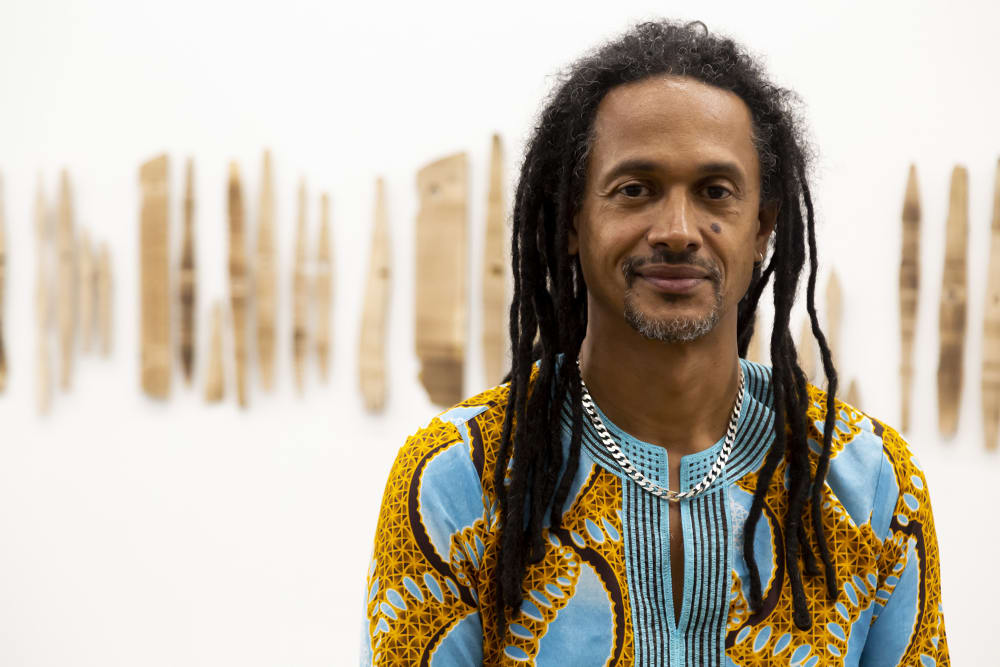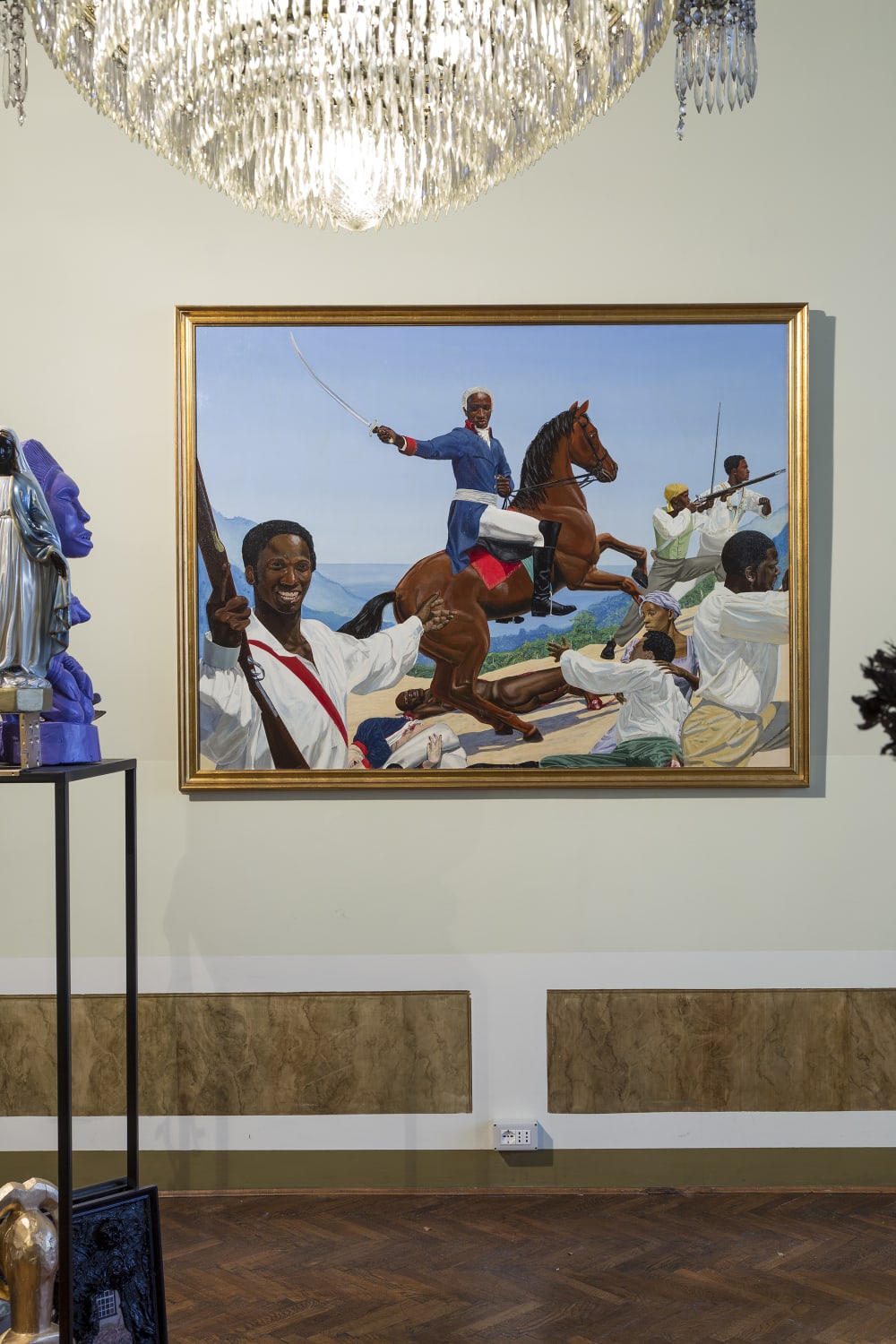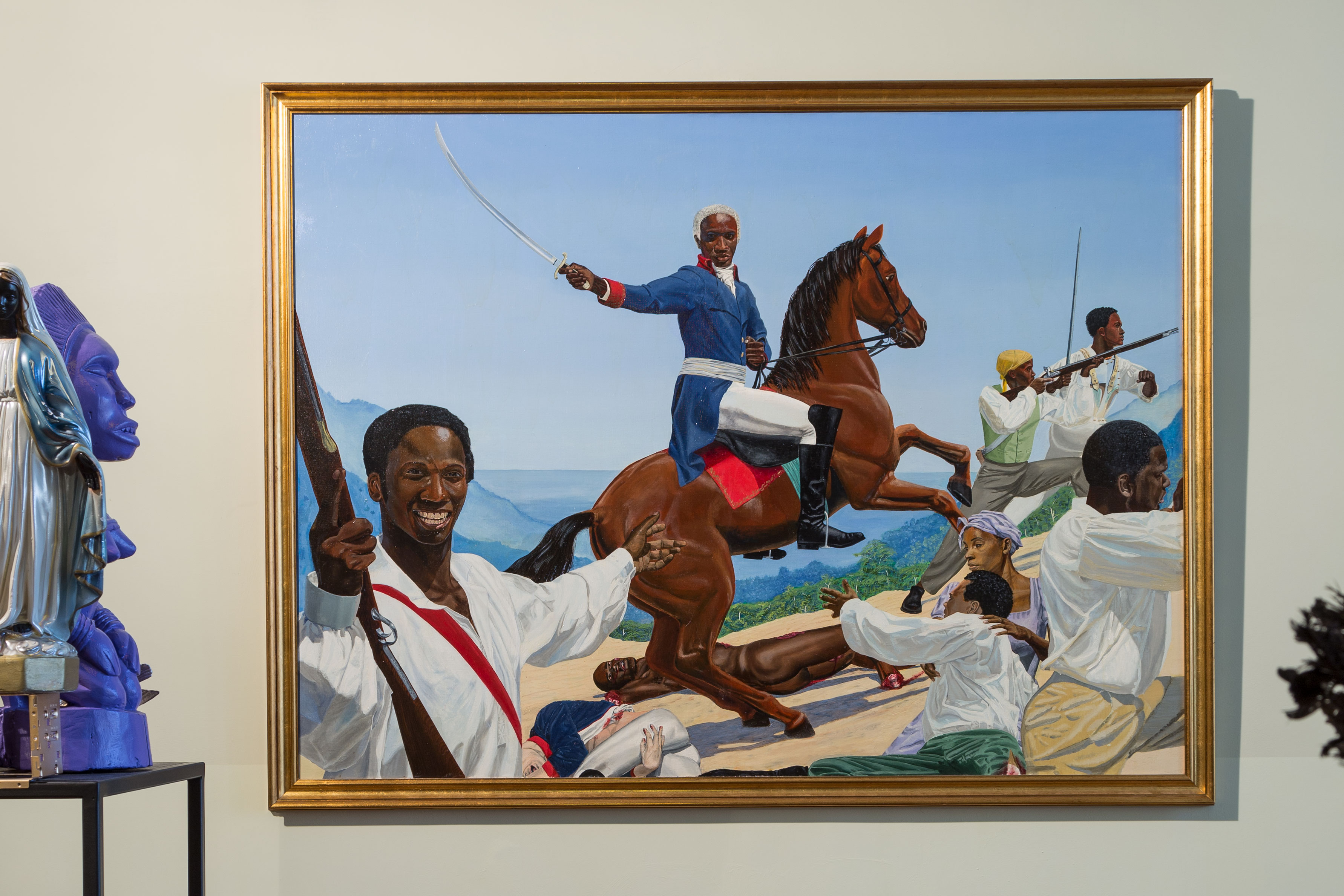Artist Dr Kimathi Donkor has been appointed as the new Course Leader for BA Fine Art Painting at Camberwell College of Arts.
He takes up his role as course leader on 1 April 2019, joining Camberwell from Wimbledon College of Arts where he is currently Acting Course Leader on MA Drawing. Former Course Leader Daniel Sturgis is now Professor in Research and will continue to teach on the course.
Born in Bournemouth, Kimathi is of Ghanaian, Anglo-Jewish and Jamaican family heritage. He is known for working predominantly in paint, but he also uses drawing, video, assemblage, collage, digital design, performance and installation to re-imagine mythic and legendary encounters across Africa and its global Diasporas, as well as contemporary themes such as urban political dissent or the pursuit of leisure, beauty and knowledge.
Having studied for his MA Fine Art at Camberwell in 2010, he completed his PhD at Chelsea College of Arts in 2016. He has exhibited internationally, including at the Diaspora Pavilion at the 57th Venice Biennale in 2017.
Our external communications coordinator, Sarah McLean, spoke to him about his ambitions for the course, the intersection of his practice as an educator and an artist, and his long-running work to diversify the fine art curriculum.

, Camberwell College of Arts, UAL | Photograph: UAL
Local area connection
Sarah: Congratulations on your appointment! I’m going to open this conversation by saying that personally, it makes perfect sense to see you take up a role at Camberwell College of Arts. We have worked together before at the gallery Peckham Space (now Peckham Platform) which was part of the college at the time, so I associate you with both the local area and Camberwell, specifically. Can you talk about that connection?
Kimathi: Thank you and you’re right, I do have quite a history in the area. The commission that we worked on together at Peckham Platform, entitled 'Daddy I want to be a black artist', was an amazing project and actually, it had a profound impact on my practice. It marked a turning point in certain ways that I paint. Working on the pieces for that show, I decided to rethink the processes I was using.
While they were and still are very related to observation, drawing and photography – what you could describe as naturalism and realism - through that project I started to reconnect with the more imaginative side of my practice. I began thinking about creating figures, scenes and narratives which were more imaginary and based on memory. This made me less tied to the camera, less dependent on photographic images and more prepared to create images with my bare hands, as it were.
The other significant connection I have with Camberwell, of course, is that I did my Masters there. In fact, when the new intake of BA Fine Art Painting students join us this autumn it will be a decade since I, myself, was a new student at Camberwell.
In some ways I ask myself, in the last 10 years, why haven’t I gone further afield? But in the intervening time I have actually taught in lots of different places. In the last few years alone I’ve worked at Goldsmiths, Middlesex, the Royal College of Art (RCA), Central Saint Martins (CSM) as well as Camberwell, Chelsea and Wimbledon - almost all of the fine art institutions in London.

, Camberwell College of Arts, UAL
Teaching
Sarah: I suppose when London has such a high concentration of excellent art colleges, it’s easy to broaden your teaching experience across a variety of institutions while staying in just one city. For example, UAL was just announced as being in the top 2 in the QS World University Rankings by subject 2019, with another London college at the top spot.
Kimathi: Absolutely. For me, these rankings are not the be all and end all, but it's certainly something that makes me very proud of what we are doing as a group of teachers and students at the university.
And it's not really a surprise! When I walk into the studios at Camberwell I am always impressed by the amazing things that are happening there. One of the things about being an art teacher is being envious of one’s students, which I constantly am.
Sarah: Envious of what?
Kimathi: Their ideas, their creativity, their approach - their work. The amazing things that they come out with! I don't want to sound disingenuous about it but I suppose to some degree I don't think that we teach them - what we try to do is provide an environment where their creativity can flourish, and allow them to reflect upon it and to own it.
So, in terms of this particular role, it is an enormous honour to be able to work with such an inspiring group of people. And not just the students, but the staff too. The staff at Camberwell are so creative in their constant quest to bring out the best in their students.
Dr Kimathi Donkor talks about the Diaspora Pavilion at the Venice Biennale in 2017 in this film made for the Arts Council by Mike Harris.
Social impact
Sarah: One of the themes which runs through a lot of the work done by staff and students at Camberwell is about driving social impact. As an artist, a lot of your work also seems to explore or link to social concerns. I think this is particularly interesting in a fine art context. Do you see a synergy between your own work and the college’s ethos?
Kimathi: It's a really interesting set of points. I chose to study my MA at Camberwell because of its siting in a particular part of south east London. It’s one of the few places where you can get good Caribbean take-away! And I'm using that fact to illustrate a point about the area – it's vibrant, there are a lot of people from all over the world there, a lot of black people there, a working class area undergoing gentrification – a place with a specific set opportunities and challenges. It's a college which is situated physically in a dynamic community in London.
One of the things Peckham Platform tries to do, and I think is part of the ethos we're trying to create at Camberwell, is for art to have that sense of being not simply for the elite but something that can allow ‘real’ people to express their concerns, have fun with and appreciate. Certainly, that vision of a socially-engaged practice which has a wider field of operation than the world of the megarich is really important to me and always has been.
It's a difficult balance to strike because in many ways, speaking for myself but also for maybe also for my colleagues, as a painter (and I mean that as a panel painter of oil paintings rather than the expanded field of painting) you are kind of creating luxury goods.
It’s important to me to allow our students to have a professional engagement which is versatile, which enables them to be able to move through different strands of society and still be true to themselves. I also think another part of my mission is for the course at Camberwell to be attractive to young people in the area. I know that the university has got a strong programme of outreach and recruitment in this area and it's an ambition of mine that people who are going to Harris Academy in Peckham, for example, will see that this is a place that they could aspire to attend.

, Camberwell College of Arts, UAL
Decolonising the curriculum
Sarah: Last time I saw you we were both at a workshop about decolonising the curriculum. I know you have been involved with Shades of Noir which has been a long running programme here at UAL. It's really interesting, much needed work, I think. I wondered if you could talk about that?
Kimathi: It definitely ties in with both my interests as an artist and as an educator. When I started my PhD in 2010, I had identified ways in which I felt that the curriculum at the university could be reformed in terms of its whiteness. I felt, and a lot of other people felt too, that the references, the way that people were being taught, the staffing, the vision, were all very Euro-centric.
It was based, I suppose, on a set of values created probably in one of the worst periods of history - the 1920s and 1930s, when modernism flourished. This was at a time of global segregation, empires and fascism. A lot of the discourses around art were rooted in western Europe and North America from that time and that still has a big legacy. However, in the intervening period we have seen mass migration, decolonisation, globalisation and transformation of the world to a degree. I think that art as a mirror to society, or even as a mirror to the individual who is in a society, must reflect those changes.
Over the years I've been involved in initiatives like Shades of Noir and the Retain, Achieve, Succeed Research Programme (RAS). I happened to be teaching, for example, at CSM on black thought in art and brought those seminars to Camberwell, Chelsea and Wimbledon.
Other initiatives I've worked on have been related to my interest in black African and Asian colonial and anti-colonial histories. I’ve tried to express these through my artwork and through my teaching I've been able to bring those aspects into the college, as part of a general movement along with people like Aisha Richards, Director of Shades of Noir, Sonia Boyce artist and UAL Professor of Black Art and Design and Professor Paul Goodwin, Director of UAL’s Research Centre for Transnational Art, Identity and Nation (TrAIN). Sophia Phoca, Dean of Fine Art for Camberwell, Chelsea and Wimbledon is very keen to have a decolonisation focus in the fine art curriculum and it's taken off.
In terms of my practice, I think I suppose the reason I'm talking about the teaching is because my practice has always had a didactic element. My paintings have always alluded to stories, implying there was more the viewer needed to know. I bring in characters, figures and places which are related to my heritage as a person of African descent, the history of the Caribbean and the black diaspora. They're not the sole aspect of my work but they have always been a very centrally important thread through my painting practice, my drawings, my film-making.
That’s why it’s important to me to be part of an educational programme that's got those values at its heart. The student population has become more diverse with a continued influx of students from around the world, as well as more black and Asian students from the UK. We also have a rich cultural mix at our colleges that goes beyond nationality and race, in terms of gender diversity and sexuality. The idea of equality and diversity is strongly embedded in the ethos of Camberwell, the university and the course and I’m really excited about the opportunity to help that flourish. It's a really exciting time for the university, for me and the hopefully the students.
Find out more about BA Fine Art Painting at Camberwell College of Arts.

